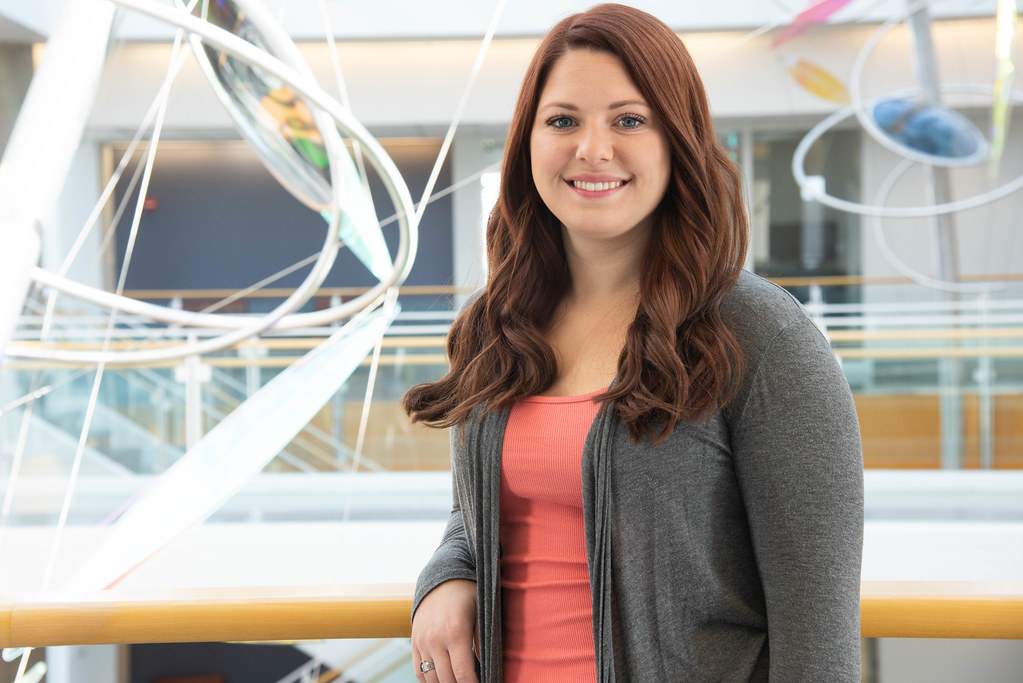Published on
Ashley Meyer | photo by Mariah Cox, Bond LSC
By Becca Wolf | Bond LSC
When given an opportunity to use the newest technology, one has to take it.
Ashley Meyer, the lab supervisor of the Wes Warren lab at Bond Life Sciences Center, recently started using the improved technology of single cell RNA sequencing to create an Immune Cell Atlas for chickens. This search browser of sorts allows people to search for cells and gene expression in chickens.
“It would be a platform for researchers to have a baseline of what should be normal, and then be able to run comparative experiments to say ‘Okay, if we challenge this chicken with this disease, what biological response are we seeing?’ Which can help you then understand the disease better,” Meyer said. “Like, ‘How is it being transmitted? How is this chicken reacting to it?’”
Poultry is one of the largest agricultural industries in Missouri, so it is important to keep chickens healthy.
“The Immune Cell Atlas will help us analyze tissues and will help us perform the single cell RNA sequencing on them to ask what’s normal and what’s diseased so that we can see what’s happening,” Meyer said. “It will also allow us to see which chickens are more susceptible than others or how the progression diseases happen.”
Meyer and the Warren lab are some of the first researchers to apply this technology to chicken based research.
Single cell RNA sequencing (RNAseq) allows Meyer to sequence the RNA of an individual cell which provides in-depth data. This can be done using single cell RNAseq which uses the entire cell, or it can be done using single nuclei RNAseq which uses just the nucleus of a cell. This profiles gene expression in cells that make up a tissue to get data on a cellular level to understand the composition of cells.
It is important to target the RNA because it is the messenger that brings instructions from the DNA for controlling the synthesis of proteins. RNA is commonly synthesized in the nucleus of a cell.
“We’re some of the first people to get our hands on some avian single cell data, specifically looking at nuclei. My job is a lot of optimizing these protocols to isolate these nuclei,” Meyer said.
Using nuclei allows Meyer to use samples that have been frozen, collected in other locations, etc., which provides more flexibility.
Isolating the nuclei through RNAseq allows Meyer to identify different cell types based on genes being expressed in a cell in an organ such as a spleen or lung. This information can then be added to the Immune Cell Atlas.
Meyer is a part of a team working on this project including two master’s students, a bioinformatics analyst, and principal investigator, Wes Warren, at Bond LSC, as well as a bioinformatics analyst who works remotely from Santa Cruz, California.
While the team is working from around the country, they are all connected by a common goal.
“Things have been pretty hectic, the break with the COVID quarantine kind of paused everything and then when we got back it just kind of took off, we’ve generated a couple data sets just in the last month or so,” Meyer said.
Having started this research about six months ago, they still have a way to go. Meyer and her collaborators are currently focused on analyzing five to six immune system organs, and plan on expanding in the future.
Since single cell RNAseq is so new, it can be challenging being one of the first labs to use it at MU and in the avian community.
“Since it’s still newer, everyone’s still figuring out how it works,” Meyer said. “Everybody’s determining their own way of analyzing the data. We’re working through the hiccups of everything, and not having years and years of research to guide us can be challenging; however, also exciting because then we can find what works and what doesn’t work which is the whole point of science.”
While challenging, it is rewarding. Meyer hopes that in the future once they have created the chicken Immune Cell Atlas, they are able to expand to other animals.
“It’s exciting to be part of something that’s newer and having something that could be beneficial for other researchers,” Meyer said. “I am a huge advocate for sharing science and teaching science so creating something to aid other research is super empowering for me.”
